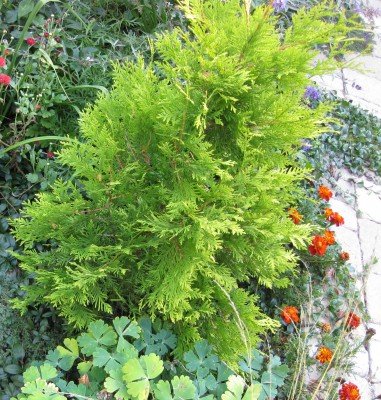
Just because perennials have died back to ground level, the earth is frozen under a layer of white stuff and crickets have chirped their last for 2010 doesn’t mean garden appreciation is over. Now is the time to consider the winter garden, and my hope is that you have some coniferous shrubs to give character and substance in this cold season.
There’s a lot that can be said about designing a garden for winter interest, but the easiest thing to do is include dwarf conifers whenever you can — certainly by doorways and entrances, along paths and anywhere you’ll see them most days through the cold months. When considering coniferous plants, the term dwarf is relative. It doesn’t always mean small or tiny, but indicates the plant will be smaller in stature than the original species. For instance, dwarf globe blue spruce (Picea pungens ‘Glauca Globosa’, Zone 3) grows up to four feet tall and wide (120 x 120 cm), while standard blue spruce (Picea pungens, Zone 3) can reach 60 feet (20 m) in height and 12 feet (4.5 m) in width. So that’s the difference.
Probably the most useful place for dwarf coniferous shrubs is in perennial beds. These plants need to be upright, and easily maintained (with simple and not too frequent pruning, usually once or twice a season) to five feet (1.5 m) or less in height and spread, and with enough substance to have presence in winter snow, but not overpower perennials in summer. As well, the conifers should be fine in texture and complement flowering plants. To my eye, one of the best is Mint Julep juniper (Juniperus chinensis ‘Monlep’, five x five feet/1.5 x 1. 5 m, Zone 5). Its arching, fountain-like branches stay green in winter without darkening (as many conifers do in the cold), and can be easily trimmed to allow perennials lots of space around it. Also consider ‘Green Mountain’ boxwood (Buxus ‘Green Mountain’, five feet x 40 inches/1.5 x 1 m, Zone 6) with strong upright growth that can be trimmed into a formal cone. ‘Slowmound’ Mugo pine (Pinus mugo ‘Slowmound’, 40 x 40 inches/1 x 1 m, Zone 3) is strong enough to stand up to heavy snow and deep cold. Hill’s yew (Taxus x media ‘Hillii’, Zone 5) and Hick’s yew (T. x media ‘Hicksii’, Zone 5) both grow 10 feet (3 m) tall and 40 inches (1 m) wide, with straight upright form. Hill’s and Hick’s yews can be flat-topped pruned to four or five feet (1.2 to 1.5 m) in height; spreading plants like Mint Julep juniper can be tip-pruned to keep them contained. Looking out your window, dwarf conifers will be a welcome sight in an empty perennial bed on a cold winter’s day.
My misplaced cyclamen
Hardy cyclamens are other plants that add interest on cold December days. Most cyclamens have elaborately patterned green and white leaves (standing about four inches/10 cm tall), and Cyclamen hederifolium in my front shade bed has been in full beautiful foliage, but is now covered in snow. Last spring I took a tray of cyclamen seedlings out from under the basement lights, with the intent to install them in the garden. I put the tray under a shrub where they were to be planted, and then forgot them. So the seedlings passed the summer in that spot—first too dry, then too wet, and finally frozen for a few days until eventual discovery. Ten days ago I took them back inside for rehabilitation.
And it gets worse. This week there was a small indoor explosion of houseflies that I erroneously attributed to the cyclamens’ soil, and so the tray went back outdoors and froze on the porch. The houseflies are now known to be cluster flies and have nothing to do with the cyclamen seedlings, so the tray has been taken in, again. You must wonder why I’m allowed to have these plants! Well, I’m sorry for the neglect and abuse, and will try to do the right thing with these bedraggled seedlings. They need fresh pots with some grit-enriched soil, and then they’ll be put under the lights until next spring.
Growing cyclamens from seed is an interesting winter project. After initially planting the seeds, they spend six weeks in complete darkness, then quickly make the sweetest little corms, with one leaf boldly thrust upward. If you’re interested to try, see The Cyclamen Society website for information (cyclamen.org). The hardiest species (Zone 5 or 6 with winter mulch) are fall-blooming C. hederifolium, spring-blooming C. coum and summer-blooming C. purpurascens. A good selection of seeds can be ordered from Chiltern Seeds (chilternseeds.co.uk). And did I mention that the white, pink and red flowers are charming, and often candy-scented? They’re hardy cousins to the tender florist cyclamen (C. persicum) sold in every supermarket at this time of year. I hope you’ll try growing some, but please be a better parent than I am.








